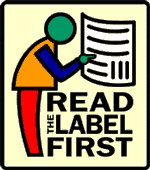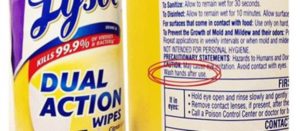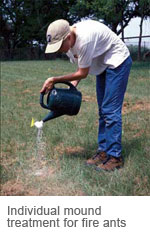
Before you use any pesticide product read the label first.
The U.S. Environmental Protection Agency, EPA, recognizes February as National Pesticide Safety Education Month.
Texas A&M AgriLife Extension Service’s Pesticide Safety Education and Extension faculty encourage the public to take the time this month to better understand the role pesticides play in our daily life and how to properly use them, since pesticides can present potential dangers when misused, mishandled, or incorrectly stored.
“During National Pesticide Safety Education Month, we should reflect upon the vital role that pesticides play in protecting our health and ensuring a stable food supply while also acknowledging that if not used correctly, pesticides can cause harm to people and the environment”, said Mark Matocha, Ph.D., AgriLife Extension agricultural and environmental unit pesticide safety education specialist, Bryan-College Station.
To aid in that effort, the EPA has expanded the scope of information available including new resources and videos in Spanish, said Matocha.
Pesticides are regulated by the EPA and represent a broad category that applies to far more products than the average consumer might imagine. Everything from cleaning products and antimicrobials to herbicides and bug repellents are pesticides.
Pesticides and public perception
“Most often, the public has the perception that pesticides are dangerous with few benefits to society”, said Don Renchie, Ph.D., AgriLife Extension pesticide safety education specialist and program leader and coordinator, Bryan-College Station.
“The truth of the matter is that without the judicious use of pesticides, things we take for granted in daily life would be vastly different”, he said. “The public water supply in the U.S. relies on pesticides to remove biological contaminants; mosquito control programs rely on pesticides to prevent the spread of disease; and pesticides are instrumental in preventing food pest depredation”.
Land-grant university driven pesticide education
The National Stakeholder Team for Pesticide Safety Education Program Funding was formed in 2012 to strengthen and support the land-grant university Pesticide Safety Education Program, PSEP.
“That effort began from the tireless work of the pesticide stakeholder team, which was spearheaded by Dr. Carol Somody”, Renchie said. “She and the team envisioned the need to bring attention to the role pesticides play in everyday life, from protecting the food crops we eat to mitigating viruses such as COVID-19”.
The EPA supports land-grant university programs for the education and training of certified pesticide applicators in all 50 states and U.S. territories. PSEPs provide pesticide applicator training on the safe use of restricted-use pesticides by applicators in agricultural, commercial, and residential setting.
As a land-grant university, Texas A&M plays a key role in educating, informing, and serving all Texans. The PSEP part of that service is achieved through AgriLife Extension faculty’s pesticide safety education outreach activities statewide.
Pesticides: Not just for ‘pests’

Remember to read the label, washing hands after use should be exercised by anyone using these products without gloves.
When many people think of pesticides, they think of their utilization to eliminate unwanted insects and pests. But it’s not just about bugs, said Janet Hurley, AgriLife Extension integrated pest management specialist, Dallas.
“Most people don’t think pesticide safety is something they need to be concerned with”, she said. “But they don’t realize a lot of the chemicals they use day in and day out for cleaning, sanitizing and disinfecting — especially since the emergence of COVID-19 — are all pesticides.”
Read the label, then read it again
Consumers have been encouraged to read food labels for years, but pesticide labels haven’t received the same focus on education, Hurley said.
“The label is there to be read”, she stressed. “It will tell you everything you need to know—the active ingredients, if protective gear is needed, how much and how to use it, and potential dangers”.
She also said that it is necessary to read the label every time, as different brands and formulations can have different active ingredients and application instructions. Following directions ensures the product is being used in the safest and most effective manner possible. It also means that you are utilizing it in the most cost-effective manner and not wasting product.
“Take disinfecting wipes for an example, it doesn’t matter who makes them or what brand, you must read the label”, Hurley said. “If you’re going to use one to wipe off a countertop that may be okay, but if you’re going to wipe down a large area you need to wear gloves. People need to read the directions and follow them. They don’t all have the same active ingredient”.
Pesticides: More doesn’t equal better
Using more of a product than its labeled usage isn’t going to make it work more effectively and can even be dangerous to people and pets, she said.

Remember when using insecticides and herbicides you should always protect yourself from exposure.
Some common home-cleaning mistakes are using products in a closed room with poor ventilation. Some products used together can even cause a deadly chemical reaction.
“Most of these things people just store under their kitchen or bathroom sink and don’t really think about having these things in the reach of children or pets either”, Hurley said.
She said that just as we want to be aware of what we expose our bodies to when it comes to the food we ingest and the water we drink, the same is true for the chemicals we are exposing ourselves to when using pesticides for cleaning, addressing pest issues, or working in the garden.
“This isn’t a case where more is better”, Hurley said. “In order to protect ourselves and our environment, we have to be aware, and that requires some level of self-education to know what you are using and how to use it”.
A helpful educational website both Hurley and the EPA recommend is the National Pesticide Information Center.
Safety indoors and out
As the weather warms and people start looking forward to being outdoors more, Hurley said it is important to keep best practices in mind inside and outside.
EPA assesses the risks and benefits of all pesticides sold and distributed in the U.S. and requires instructions on each pesticide label for safe use.
The EPA’s best pesticide awareness practices include:
- Storing pesticides in their original containers with proper labels.
- Storing pesticides out of the reach of children and pets, preferably locked up.
- Using the amount specified on the label.
- Washing hands with soap and water after using a pesticide.
- Keeping children and pets from entering sprayed areas until they dry.
- Keeping pesticides away from food and dishes.
- Washing clothes that have been in contact with pesticides immediately and separately from other items.
Renchie said he wanted to remind the public to remember that it “is important that pesticides be used in strict accordance with their label directions, but it is equally important that the public realize that when used properly, pesticides enhance both the quality and quantity of life”.
Written By Susan Himes, Communication Specialist, Texas A&M AgriLife

 .
.